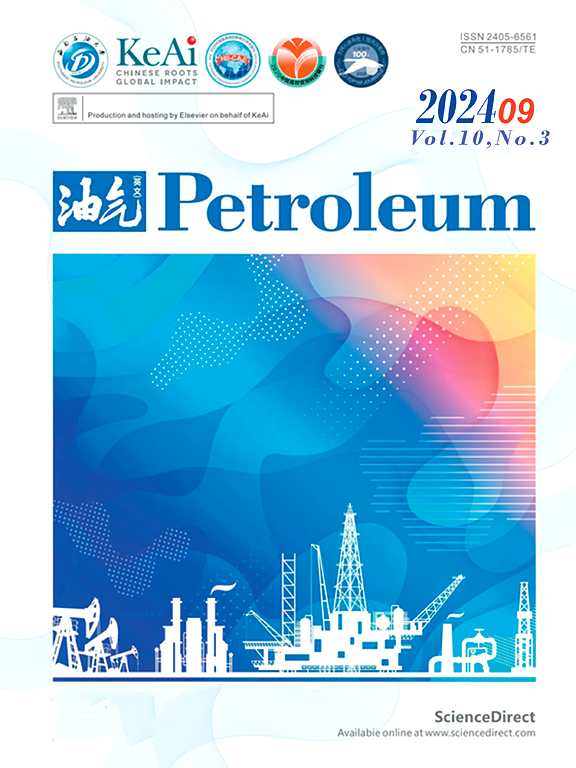Low-temperature oxidation characteristics and reaction pathways of crude oil within tight shale during air injection
IF 3.5
Q2 ENERGY & FUELS
引用次数: 0
Abstract
The investigation of low-temperature oxidation (LTO) of crude oil within tight shale holds significant importance due to its implications for subsequent oxidation reactions and enhanced oil recovery in the process of air injection. In this study, the tight shale sample underwent oxidation at various LTO temperatures, followed by an analysis of the resulting gas composition. Furthermore, the oxidized oil was separated from the tight shale and subjected to characterization using electron paramagnetic resonance, nuclear magnetic resonance, and negative ion electrospray Fourier transform-ion cyclotron resonance mass spectrometry techniques. The primary focus was on examining the distinct LTO reaction pathways observable across different temperature ranges. The findings demonstrated a correlation between LTO temperature and the concentration of free radicals, which predominantly resided on aromatic hydrocarbons, alkanes, and oxygen atoms. Additionally, the proton count of polycyclic aromatic hydrocarbons exhibited a continuous increase from 83 to 350°C, suggesting intensified aromatization and condensation reactions involving aliphatic and aromatic compounds. With rising LTO temperature, the molecular structure of O2 compounds underwent significant transformations, characterized by increased condensation degree and a decrease in low carbon number molecular structures, while higher equivalent double bonds and carbon number molecular structures became more prevalent. The LTO reaction pathways of shale oil included cycle paths 1, 2, and 3. The influence of cycle path 1 diminished at temperatures ranging from 83 to 150°C and 250 to 350°C, whereas the significance of cycle paths 2 and 3 increased, resulting in an overall escalation of the oxidation rate with temperature elevation. It was observed that the shale oil LTO process exhibited a negative temperature coefficient within the temperature range of 150 to 250°C, emphasizing the criticality of overcoming the energy barrier in this region to achieve stable combustion. This comprehensive investigation provides valuable insights into the mechanisms underlying LTO in crude oil confined within tight shale.
注气过程中致密页岩内原油低温氧化特征及反应途径
致密页岩中原油低温氧化(LTO)的研究具有重要意义,因为它对后续的氧化反应和注气过程中提高原油采收率具有重要意义。在这项研究中,致密页岩样品在不同的LTO温度下进行氧化,然后对所得气体成分进行分析。利用电子顺磁共振、核磁共振、负离子电喷雾傅立叶变换-离子回旋共振质谱等技术对致密页岩中氧化油进行表征。主要重点是研究在不同温度范围内观察到的不同LTO反应途径。研究结果表明,LTO温度与自由基浓度之间存在相关性,自由基主要存在于芳烃、烷烃和氧原子上。此外,从83℃到350℃,多环芳烃的质子数持续增加,表明脂肪族和芳香族化合物的芳构化和缩合反应加剧。随着LTO温度的升高,O2化合物的分子结构发生了明显的变化,缩合度增加,低碳数分子结构减少,高当量双键和高碳数分子结构更加普遍。页岩油LTO反应路径包括循环路径1、循环路径2和循环路径3。在83 - 150°C和250 - 350°C的温度范围内,循环路径1的影响减弱,而循环路径2和3的重要性增加,导致氧化速率随温度升高而整体上升。研究发现,页岩油LTO过程在150 ~ 250℃温度范围内呈现负温度系数,强调了克服该区域能量势障以实现稳定燃烧的重要性。这项全面的研究为致密页岩中原油的LTO机制提供了有价值的见解。
本文章由计算机程序翻译,如有差异,请以英文原文为准。
求助全文
约1分钟内获得全文
求助全文
来源期刊

Petroleum
Earth and Planetary Sciences-Geology
CiteScore
9.20
自引率
0.00%
发文量
76
审稿时长
124 days
期刊介绍:
Examples of appropriate topical areas that will be considered include the following: 1.comprehensive research on oil and gas reservoir (reservoir geology): -geological basis of oil and gas reservoirs -reservoir geochemistry -reservoir formation mechanism -reservoir identification methods and techniques 2.kinetics of oil and gas basins and analyses of potential oil and gas resources: -fine description factors of hydrocarbon accumulation -mechanism analysis on recovery and dynamic accumulation process -relationship between accumulation factors and the accumulation process -analysis of oil and gas potential resource 3.theories and methods for complex reservoir geophysical prospecting: -geophysical basis of deep geologic structures and background of hydrocarbon occurrence -geophysical prediction of deep and complex reservoirs -physical test analyses and numerical simulations of reservoir rocks -anisotropic medium seismic imaging theory and new technology for multiwave seismic exploration -o theories and methods for reservoir fluid geophysical identification and prediction 4.theories, methods, technology, and design for complex reservoir development: -reservoir percolation theory and application technology -field development theories and methods -theory and technology for enhancing recovery efficiency 5.working liquid for oil and gas wells and reservoir protection technology: -working chemicals and mechanics for oil and gas wells -reservoir protection technology 6.new techniques and technologies for oil and gas drilling and production: -under-balanced drilling/gas drilling -special-track well drilling -cementing and completion of oil and gas wells -engineering safety applications for oil and gas wells -new technology of fracture acidizing
 求助内容:
求助内容: 应助结果提醒方式:
应助结果提醒方式:


